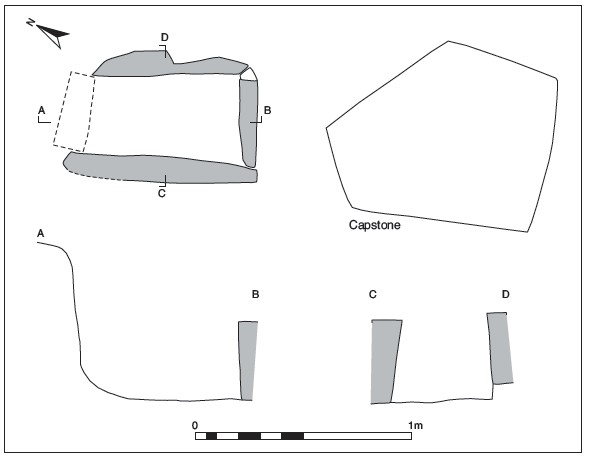County: Wexford Site name: KNOCKBRACK, CO. WEXFORD
Sites and Monuments Record No.: SMR WX002-066 Licence number: E1188
Author: MARY CAHILL
Site type: Early Bronze Age graves
Period/Dating: —
ITM: E 709389m, N 709389m
Latitude, Longitude (decimal degrees): 52.736705, -6.380143
Introduction
In December 1995 a short cist containing a bowl was discovered on a farm at Knockbrack near Gorey, Co. Wexford. The capstone of the cist had been accidentally removed during ploughing. The site was reported to the NMI and a rescue excavation was carried out by Mary Cahill. No human remains were found in the cist.
Location (Fig. 3.229)
The cist was in the townland of Knockbrack, north Co. Wexford.365 The SMR lists a cist in the nearby townland of Annagh More.366

Description of site
The cist was rectangular in plan, with its long axis aligned north-west/south-east. It measured 0.69m long by 0.41m wide by 0.4m high (Fig. 3.230). Although the north-western end stone had been removed, it was possible to see that the cist had originally been formed of four edgeset slabs, one at each side. These were of average size, the maximum dimensions being 0.89m long by 0.11m thick by 0.38m high. The floor of the cist was not paved but was formed of packed earth. The eastern side stone did not rest on the floor of the cist but on earth approximately 0.05m from the base. The capstone had been removed from the cist. It measured 1.09m long by 0.83m wide by 0.18m thick.


The cist contained a tripartite bowl but no human remains were found. It was not possible to establish the exact position of the bowl within the cist as it had been removed prior to excavation. It is possible that the cist contained an inhumation and that the acidity of the soil destroyed the bone.
Tripartite bowl, 1995:186 (Fig. 3.231)
The bowl is of tripartite type. The vessel is defined by a pair of horizontal ribs, the upper decorated with oblique lines forming a herringbone pattern, and the lower by a chevron in false relief. The rim has a row of oblique lines with a partial inner row of lightly incised lines. The upper zone is decorated with a sequence of two alternating rows of nail impressions and oblique strokes followed by a chevron in false relief. The middle zone is decorated by falserelief chevrons and a row of oblique lines. The lower zone is decorated by four alternating rows of false-relief chevrons and three rows of oblique lines. The base has a random pattern of lightly incised lines.
Dimensions: H 10.6cm; ext. D rim 13.7cm; D base 6.35cm.
Comment
As there were no human remains present in the cist at the time of excavation it was not possible to date this site. There was nothing to suggest that the site had been previously disturbed and it would be unusual for an unburnt skeleton to have decayed completely except in very acidic conditions. The tripartite bowl from the cist can be compared to bowls in Brindley’s (2007, 245–8) stage 2, which is dated to 2080–1980 BC.
365. Parish of Kilnahue, barony of Gorey. WX002-066——. IGR 309463 166259.
366. WX002-025——. IGR 31250 16544.